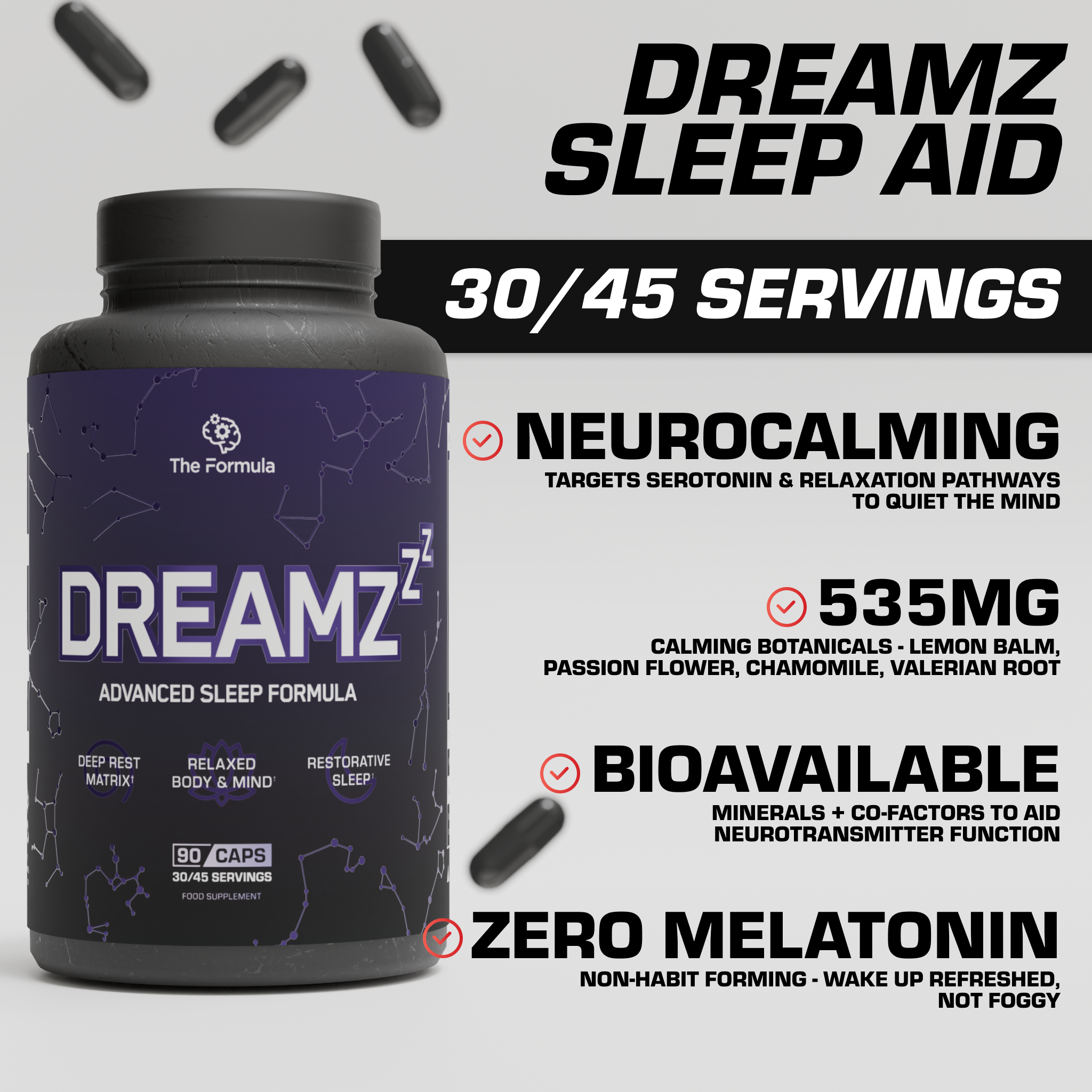The supplement industry is flooded with sleep aids promising miracles but delivering very little. Most are under dosed, stuffed with vague herbs or offer just one route to ‘help’ you sleep. DREAMZ is built differently.
Every ingredient is clinically backed, purpose-chosen and dosed with intent. It supports your body’s natural sleep processes, targets multiple pathways and helps you wind down without next-day grogginess.
Let’s break down each ingredient – why it’s in the formula, what the science says, and how it works to support your best sleep yet.
L-Theanine – 200mg
A calming amino acid found in green tea, L-Theanine promotes relaxed alertness and reduces stress without making you drowsy (one piece of the sleep puzzle: reduce stress & relax). It’s ideal for winding down at night – especially if you’ve consumed caffeine during the day.
Studies show that L-Theanine:
· Improves sleep onset latency, total sleep time and overall sleep quality [1]
· Helps balance overstimulation from caffeine [2]
· Supports healthy habitual sleep efficiency, especially in older adults [3]
L-Theanine works by modulating alpha brain waves and enhancing GABA production, easing the transition into sleep.
Lemon Balm Extract (200mg)
Lemon Balm (Melissa Officinalis) is a calming herb that interacts with the GABA system to reduce anxiety and mental restlessness – two major causes of sleeplessness
Backed by multiple human studies, lemon balm has been shown to:
· Reduce symptoms of anxiety and insomnia in as little as 15 days [4]
· Improve sleep-related quality of life, particularly in women with sleep disturbances [5]
· Works synergistically with other calming herbs and amino acids [6]
Passion Flower Extract (200mg)
Passion Flower increases extracellular GABA in the brain, calming the nervous system and enhancing sleep quality. It operates via a multi-target mechanism – not just mimicking sedatives but encouraging natural GABA activity.
What the science says:
· Shown to improve total sleep time and sleep quality in clinical studies [7] [8]
· Enhances deep sleep and reduces REM in rodents via GABA receptor modulation [9]
· Contains chrysin, a flavonoid that mimics GABA’s calming effects but without benzodiazepine-related side effects [9]
It’s well-tolerated, non-habit forming and a great addition to any stress-relief or sleep stack
Valerian Root Extract (75mg)
Valerian is another herbal sleep aid that supports sleep onset, reduces restlessness and promotes deeper sleep
Mechanisms and benefits:
· Enhances GABAergic activity and acts on the adenosine A1 receptor, both essential for initiating sleep [11] [12]
· Meta-analyses show significant improvement in sleep quality over placebo with minimal side effects [10]
· Contains active compounds like valerenic acid, which have direct sedative action [12]
DREAMZ uses a 75mg dose to complement other ingredients without over-sedating.
Chamomile 4:1 Extract (60mg)
Chamomile is rich in apigenin, a flavonoid with sedative effects. It works on GABA receptors and may inhibit CD38, a target linked to healthy aging and sleep restoration
Key findings:
· Herbal blends with chamomile significantly improve subjective sleep quality in insomniacs [13]
· Apigenin shows clear sedative effects in preclinical studies, supporting its traditional use [14]
The 4:1 extract in DREAMZ ensures you get a potent, bioavailable dose that works
5-HTP (200mg)
5-HTP (5-Hydroxytryptophan) is the direct precursor to serotonin, which is then converted into melatonin, your sleep hormone
Clincial evidence supports:
· Improved subjective sleep quality and REM sleep metrics in both healthy adults and Parkinson’s patients with REM sleep disorder [15] [16]
· Helps reverse caffeine-induced insomnia when combined with GABAergic agents [17]
Magnesium (200mg as Magnesium Bisglyincate Chelate)
Magnesium calms the nervous system by acting as an NMDA receptor antagonist [20] and promoting GABA signalling. The bisglycinate chelate form is highly bioavailable and gentle on the stomach. It’s chelated with glycine – a calming amino acid that itself supports sleep
Clinical insights:
· Improves self-reported sleep quality and reduces insomnia symptoms [18]
· Supports stress resilience and reduces nighttime cramping, which can wake you up [19]
Vitamin B6 (10mg as Pyridoxal 5’-Phosphate)
Vitamin B6 in its active form (P5P) is a key coenzyme in neurotransmitter synthesis.
· Converts 5-HTP into serotonin (then that converts into melatonin) [21]
· Helps convert glutamate into GABA [21]
· Improves cellular magnesium uptake [21]
Without B6, your 5-HTP and magnesium simply don’t work as efficiently. That’s why it’s a critical component in DREAMZ.
Zinc (10mg as Zinc Bisglycinate Chelate)
Zinc plays a direct role in regulating sleep:
· Modulates GABA-A receptors, enhancing calmness [23]
· Acts as a NMDA antagonist, reducing excessive neural activity [24]
· Supports melatonin synthesis - deficiency can disrupt circadian rhythm [25]
Zinc bisglycinate is gentle on the gut and highly absorbable, making it the perfect form for evening supplementation.
Why DREAMZ Stands Apart
DREAMZ isn’t just a capsule filled with sleepy herbs. It’s a multi-pathway, clinically supported formula designed to address every stage of the sleep process:
· Relaxation: L-Theanine, Lemon Balm, Passion Flower
· Neurotransmitter Balance: 5-HTP, Vitamin B6, Zinc, Magnesium
· Deep Sleep Support: Valerian, Chamomile
· Bioavailability: Chelated minerals, synergistic blends
No underdosing. No gimmicks. Just ingredients that work - backed by science, dosed with purpose.
If you’re tired of weak formulas and ready for something real, DREAMZ is the sleep supplement that finally makes sense.
References
[1] doi.org/10.3390/proceedings2023091032
[2] doi.org/10.25259/ijpc_89_2023
[3] doi.org/10.1016/j.jff.2025.106768
[4] https://www.ncbi.nlm.nih.gov/pmc/articles/PMC3230760/
[5] doi.org/10.1055/s-0040-1721857
[6] https://pubmed.ncbi.nlm.nih.gov/29908682/
[7] https://pubmed.ncbi.nlm.nih.gov/21294203/
[8] https://pubmed.ncbi.nlm.nih.gov/31714321/
[9] https://www.ncbi.nlm.nih.gov/pmc/articles/PMC5699852/
[10] doi.org/10.1016/j.amjmed.2006.02.026
[11] doi.org/10.1177/2515690x20967323
[12] doi.org/10.3390/molecules30112344
[13] doi.org/10.1080/2331205x.2017.1380871
[14] doi.org/10.3389/fnut.2024.1359176
[15] doi.org/10.1093/cdn/nzab037_082
[16] doi.org/10.1007/s11325-021-02417-w
[17] doi.org/10.3390/ijms22010181
[18] doi.org/10.7759/cureus.59317
[19] doi.org/10.1111/j.1740-8709.2012.00440.x
[20] doi.org/10.3897/rrpharmacology.6.59407
[21] Gominak SC, Stumpf WE. Med Hypotheses. 2012;79(2):132–135.
[22] Nogovitsina OR, Levitina EV. Zh Nevrol Psikhiatr Im S S Korsakova. 2006;106(5):55–57.
[23] Hosie AM, Wilkins ME, Smart TG. Neuroscience. 2007;144(4):1355–67.
[24] Smart TG, Xie X, Krishek BJ. Prog Neurobiol. 1994;42(4):393–441.
[25] Garcia-Moreno H, López-González MA, De la Fuente M. In: Handbook of Nutrition, Diet and Sleep.Wageningen Academic Publishers, 2013.





